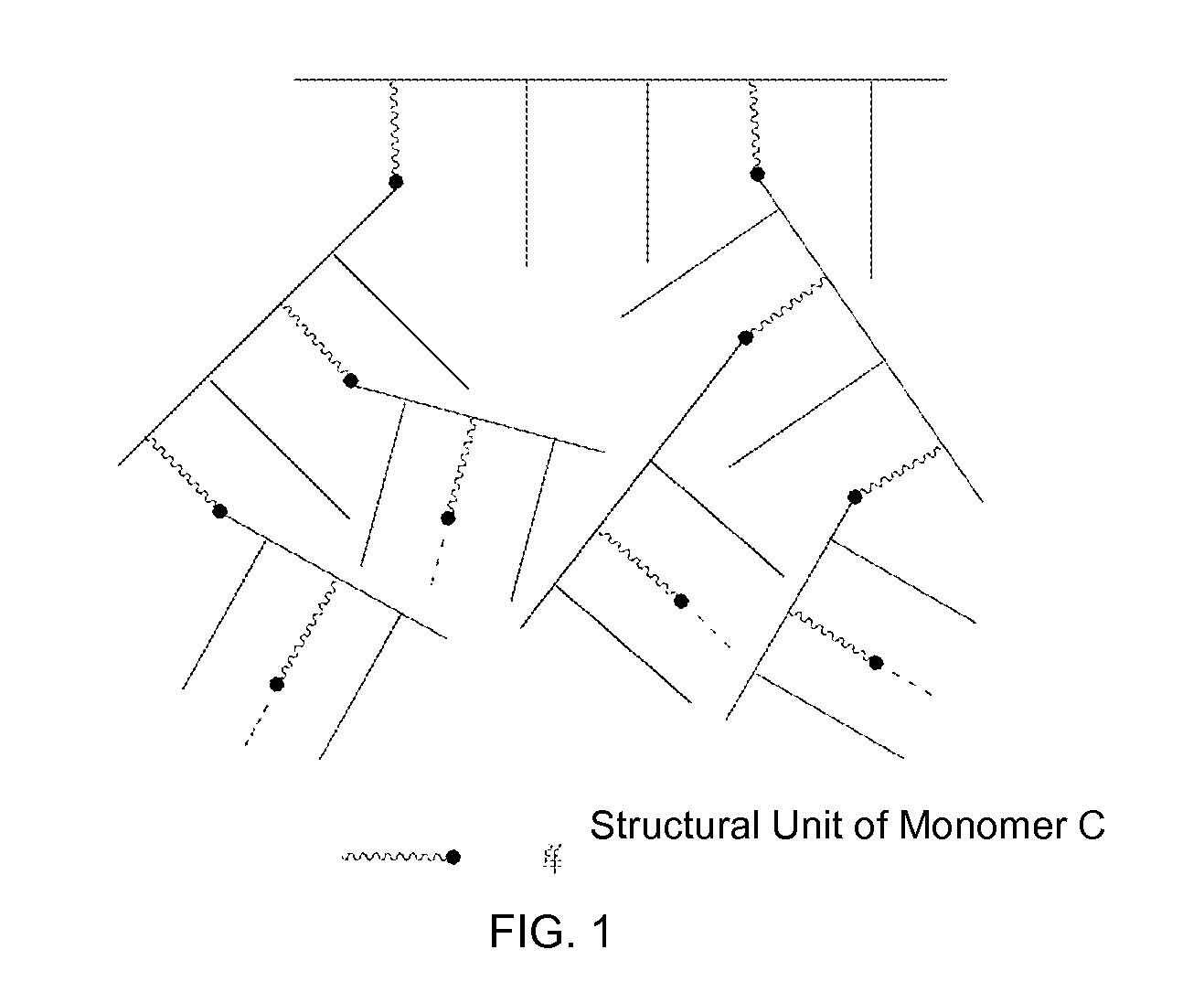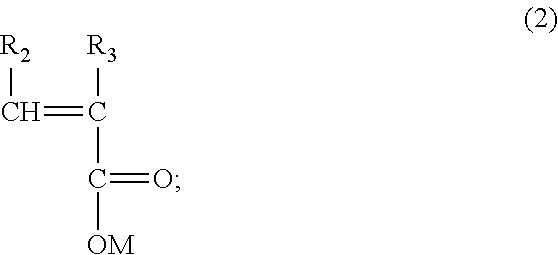Preparation method of hyperbranched polycarboxylic acid type copolymer cement dispersant
a copolymer cement and polycarboxylic acid technology, applied in the field of concrete admixtures, can solve the problems of poor adaptability, simple molecular structure, lack of effective side chains, etc., and achieve the effects of low dosage, good cement dispersion, and high water-reducing ra
- Summary
- Abstract
- Description
- Claims
- Application Information
AI Technical Summary
Benefits of technology
Problems solved by technology
Method used
Image
Examples
embodiment c-1
Esterification Embodiment C-1
[0023]Add 50 g of D-1 (0.1 mol), 11.1 g of E-1 (0.12 mol), 1.5 g of p-toluenesulfonic acid, 0.05 g of phenothiazine and 25 g of toluene into a glass flask attached with a stirrer and a water separator, and then keep stirring them and maintain the reaction temperature at 100° C., after 12 h's reaction, cool the temperature of the oil bath to 110° C. and eliminate toluene through decompression and distillation. The final weight of water separated is 1.75 g, and the esterification rate of D-1 is 98.1% measured by means of acid-base titration. To eliminate the unesterified E-1, first neutralize the esterified substances by adding the saturated sodium carbonate solution until the PH value equals to 8, since E-1 converted to salt is insoluble in ethyl acetate, extract the esterified substances with the ethyl acetate and collect the organic phases, afterwards, eliminate the ethyl acetate through decompression and distillation, and lastly dry the obtained solids...
embodiment c-2
Esterification Embodiment C-2
[0024]Add 200 g of D-2 (0.1 mol), 13.8 g of E-2 (0.13 mol), 8.6 g of p-toluenesulfonic acid, 0.10 g of phenothiazine and 75 g of toluene into a glass flask attached with a stirrer and a water separator, and then keep stirring them and maintain the reaction temperature at 110° C., after 20 h's reaction, cool the temperature of the oil bath to 110° C. and eliminate toluene through decompression and distillation. The final weight of water separated is 1.72 g, and the esterification rate of D-2 is 97.2% measured by means of acid-base titration. To eliminate the unesterified E-2, first neutralize the esterified substances by adding the saturated sodium carbonate solution until the PH value equals to 8, since E-2 converted to salt is insoluble in ethyl acetate, extract the esterified substances with the ethyl acetate and collect the organic phases, afterwards, eliminate the ethyl acetate through decompression and distillation, and lastly dry the obtained solid...
embodiment c-3
Esterification Embodiment C-3
[0025]Add 500 g of D-3 (0.1 mol), 18.1 g of E-3 (0.15 mol), 26.0 g of p-toluenesulfonic acid, 0.10 g of phenothiazine and 150 g of toluene into a glass flask attached with a stirrer and a water separator, and then keep stirring them and maintain the reaction temperature at 120° C., after 30 h's reaction, cool the temperature of the oil bath to 110° C. and eliminate toluene through decompression and distillation. The final weight of water separated is 1.70 g, and the esterification rate of D-2 is 96.3% measured by means of acid-base titration. To eliminate the unesterified E-2, first neutralize the esterified substances by adding the saturated sodium carbonate solution until the PH value equals to 8, since E-3 converted to salt is insoluble in ethyl acetate, extract the esterified substances with the ethyl acetate, and collect the organic phases, afterwards, eliminate the ethyl acetate through decompression and distillation, and lastly dry the obtained so...
PUM
| Property | Measurement | Unit |
|---|---|---|
| temperature | aaaaa | aaaaa |
| temperature | aaaaa | aaaaa |
| diameter | aaaaa | aaaaa |
Abstract
Description
Claims
Application Information
 Login to View More
Login to View More - R&D
- Intellectual Property
- Life Sciences
- Materials
- Tech Scout
- Unparalleled Data Quality
- Higher Quality Content
- 60% Fewer Hallucinations
Browse by: Latest US Patents, China's latest patents, Technical Efficacy Thesaurus, Application Domain, Technology Topic, Popular Technical Reports.
© 2025 PatSnap. All rights reserved.Legal|Privacy policy|Modern Slavery Act Transparency Statement|Sitemap|About US| Contact US: help@patsnap.com



